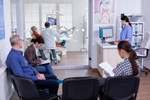Report reveals dental access confusion amid the pandemic
Published: 11/09/2020
A report by a health watchdog reveals that poor communication has led to confusion about access to dental care amid the current coronavirus pandemic.
According to the latest briefing by Healthwatch England, NHS patients have turned to private practices in order to receive treatment for what their dentist considered to be non-emergency treatment.
This, they suggest, has caused some of them extra stress while experiencing acute dental pain or other symptoms.
Before COVID-19, Healthwatch regularly heard from people who were struggling
to find a dentist in some parts of the country.
Since the start of the pandemic, the report suggests this problem has become challenging for even more people. While routine appointments were on hold, people did not know how to access emergency dental care – causing them extra stress while experiencing acute dental pain or other serious symptoms, they say.
In June, as dental practices started to reopen for routine appointments, the watchdog heard that the information being provided from some services was inconsistent or confusing, leaving people unsure about whether they were running again, and what treatment would be available.
Some people reported being told to call their dental practice by NHS111, only to be redirected back to NHS111 by the dental practice’s voicemail message.
They also heard about some cases of dentists applying additional charges to patients to cover the cost of PPE, 'making dental care even less accessible'.
The report suggests: 'It was not clear from our evidence whether people ended up paying for private treatment or were paying more than the NHS treatment band costs.
'However, since the beginning of July, people have started to tell us they feel they have no option but to go private if they want to receive treatment for what their dentist has deemed non-emergency treatment. We will continue to monitor this feedback for our next quarterly report.'
The report, which looks at people's experiences during the period of April to June, lists the major issues thrown up by the survey of 19,700 people. They include:
- The need for up-to-date information in languages or formats people understand, explaining how to protect themselves and their loved ones
- Better communication about how to access available services, and what the next steps are if support must be paused
- Problems accessing certain treatments and services, especially dental care
- Concerns about processes, such as the confusion around ‘Do Not Attempt Resuscitation’ forms without sufficient discussion in the early stages of the pandemic
- Queries about accessing testing for COVID-19
- Challenges with digital appointments because some people could not access them or felt uncomfortable using them.
When it comes to communication, it suggests that while 'digital appointments don’t work for everyone, and services should not be exclusively digital, it’s important healthcare services embrace technology for those who find it an efficient way to communicate'.
Author: Julie Bissett








.jpg?width=150&height=100&scale=canvas)




